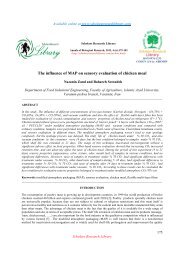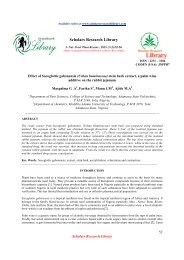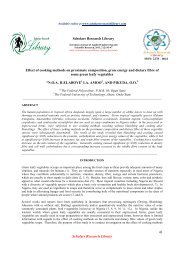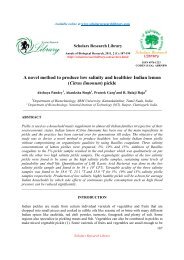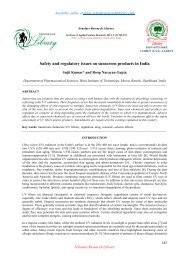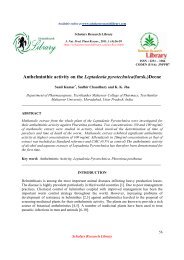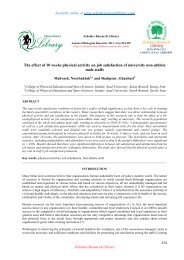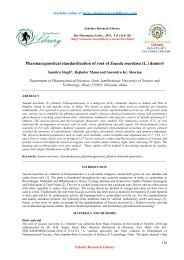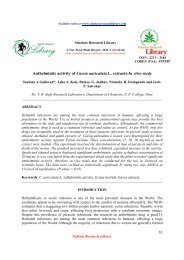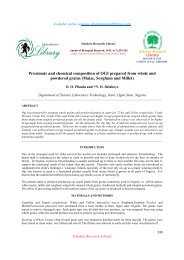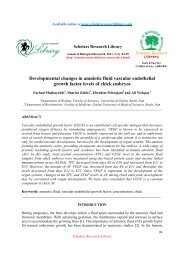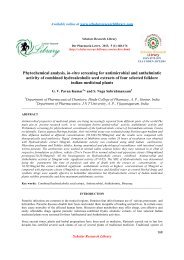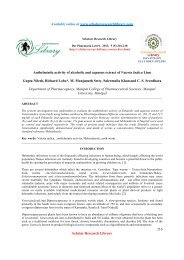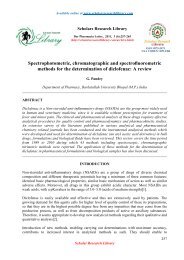Regulation for safety and quality of cosmetics vis - Scholars ...
Regulation for safety and quality of cosmetics vis - Scholars ...
Regulation for safety and quality of cosmetics vis - Scholars ...
Create successful ePaper yourself
Turn your PDF publications into a flip-book with our unique Google optimized e-Paper software.
Sujit Kumar et al Der Pharmacia Lettre, 2012, 4 (1):181-191<br />
_____________________________________________________________________________<br />
(sodium, potassium, aluminium, barium, calcium strontium, or zirconium) are known as "lakes"<br />
<strong>and</strong> are named using the same convention, but with the addition <strong>of</strong> the word lake <strong>and</strong> the<br />
substrate, <strong>for</strong> example: FD&C Red No. 40 Aluminium Lake. Cosmetic colours that are not<br />
subject to batch certification are known by more common names, <strong>for</strong> example: Caramel or<br />
Henna. The important thing to note is that all <strong>of</strong> these colours, both those that are subject to batch<br />
certification <strong>and</strong> those that are not, must be pre-approved, <strong>and</strong> have specifications set, be<strong>for</strong>e<br />
being used in cosmetic products in the USA. FDA also allows companies marketing their<br />
products internationally to use dual labelling <strong>for</strong> colours, listing names acceptable to the FDA as<br />
well as Colour Index (CI) numbers that are required <strong>for</strong> labelling colours in the European Union<br />
<strong>and</strong> other countries in the world. Thus, <strong>for</strong> example, a cosmetic product in the USA may bear<br />
ingredient labelling <strong>for</strong> colours such as Yellow 5/CI 19140 or FD&C Yellow No. 5/CI 19140 [9].<br />
The FDA has granted permission <strong>for</strong> the cosmetic industry to use abbreviated names on the<br />
labels <strong>of</strong> products containing the certifiable colours or lakes. For example, FD&C Blue No. 1<br />
now may be listed as Blue 1, <strong>and</strong> FD&C Red No. 40 Aluminium Lake may now be listed as Red<br />
40 Lake. The original colour names also may still be used.<br />
INDIA<br />
Rule 127 clause (2) <strong>of</strong> the Drugs <strong>and</strong> Cosmetics Rules 1945 mentions that the label on the<br />
container <strong>of</strong> a drug containing a permitted colour shall indicate the common name <strong>of</strong> the colour,<br />
<strong>for</strong> example: Quinazarine Green SS, Tartrazine, Erythrosine etc. But, the same is not true with<br />
<strong>cosmetics</strong>. No direction is given in the D&C Act <strong>and</strong> Rules regarding the nomenclature <strong>of</strong> a<br />
colouring agent.<br />
Pond’s White Beauty cream (Hindustan Unilever Ltd.) mentions CI 14700 on the label. Garnier<br />
Wrinkle Lift anti-ageing cream (Loreal India Pvt. Ltd.) does not mention any colour. Lactocalamine<br />
(Nicholas Piramal India Ltd.) mentions the colour on the label as “permitted colour”.<br />
New Ever Youth Orange Peel Off Skin Vitalizer (Cadila Healthcare Ltd.) doesot mention any<br />
colour. Artistry essentials polishing scrub (imported by Amway India Enterprises Pvt. Ltd.)<br />
mentions the colour as ultramarines. Glister toothpaste (manufactured by Sarvottam Care, India<br />
<strong>for</strong> Amway India Enterprises Pvt. Ltd.) mentions the colour as FD&C Blue No 1(CI<br />
42090).These examples prove that there is no harmonization in the nomenclature <strong>of</strong> colourants in<br />
India. Table I, compares the names <strong>of</strong> the colour additives used by USA <strong>and</strong> Indian regulation.<br />
SAFETY ISSUES<br />
EU<br />
In EU the <strong>safety</strong> <strong>of</strong> <strong>cosmetics</strong> is covered by the EC Cosmetics Directive (76/768/EEC) as<br />
amended. Annex IV to Cosmetics Directive 76/768/EEC provides <strong>for</strong> a “list <strong>of</strong> colouring agents<br />
allowed <strong>for</strong> use in cosmetic products”. The allowed use refers to different fields <strong>of</strong> applications<br />
[10]. This is implemented in UK by the Cosmetic Products (Safety) <strong>Regulation</strong>s 2008 [11]. Mica<br />
is not considered a colourant in EU <strong>and</strong> Japan. Aluminium colourants are approved <strong>for</strong> all<br />
cosmetic applications in EU <strong>and</strong> Japan. Ferric ferrocyanide may be used in externally applied<br />
<strong>cosmetics</strong> in addition to the lip area use in EU <strong>and</strong> Japan.<br />
Scholar Research Library<br />
184



